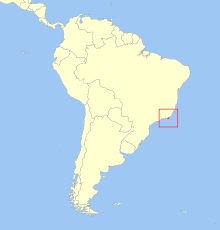You can help expand this article with text translated from the corresponding article in Portuguese. (February 2021) Click [show] for important translation instructions.
|
| Golden lion tamarin[1][2] | |
|---|---|

| |
| Male at Copenhagen Zoo, Copenhagen, Denmark | |

| |
| Female at the Bronx Zoo, New York, United States | |
| Scientific classification | |
| Domain: | Eukaryota |
| Kingdom: | Animalia |
| Phylum: | Chordata |
| Class: | Mammalia |
| Order: | Primates |
| Suborder: | Haplorhini |
| Infraorder: | Simiiformes |
| Family: | Callitrichidae |
| Genus: | Leontopithecus |
| Species: | L. rosalia
|
| Binomial name | |
| Leontopithecus rosalia | |

| |
| Synonyms | |
| |
The golden lion tamarin (Leontopithecus rosalia; Portuguese: mico-leão-dourado [ˈmiku leˈɐ̃w do(w)ˈɾadu, - liˈɐ̃w -]), also known as the golden marmoset, is a small New World monkey of the family Callitrichidae. Endemic to the Atlantic coastal forests of Brazil, the golden lion tamarin is an endangered species.[5] The range for wild individuals is spread across four places along southeastern Brazil, with a recent census estimating 3,200 individuals left in the wild[6] and a captive population maintaining about 490 individuals among 150 zoos.[3][7][8]
- ^ Groves, C. P. (2005). Wilson, D. E.; Reeder, D. M. (eds.). Mammal Species of the World: A Taxonomic and Geographic Reference (3rd ed.). Baltimore: Johns Hopkins University Press. p. 133. ISBN 0-801-88221-4. OCLC 62265494.
- ^ Rylands AB, Mittermeier RA (2009). "The Diversity of the New World Primates (Platyrrhini)". In Garber PA, Estrada A, Bicca-Marques JC, Heymann EW, Strier KB (eds.). South American Primates: Comparative Perspectives in the Study of Behavior, Ecology, and Conservation. Springer. pp. 23–54. ISBN 978-0-387-78704-6.
- ^ a b Kierulff, M.C.M.; Rylands, A.B.; M.M. de Oliveira, P.; Ruiz-Miranda, C.R.; Pissinatti, A.; Oliveira, L.C; Mittermeier, R.A. & Jerusalinsky, L. (2021) [amended version of 2019 assessment]. "Leontopithecus rosalia". IUCN Red List of Threatened Species. 2019: e.T11506A192327291. Retrieved 23 April 2021.
- ^ "Appendices | CITES". cites.org. Retrieved 14 January 2022.
- ^ Zimmer, Carl (18 January 2017), "Most Primate Species Threatened With Extinction, Scientists Find", The New York Times
- ^ "Highlights of our work in 2018 in our Annual Report".
- ^ "Current status of golden lion tamarin". National Zoological Park. Archived from the original on 24 August 2011. Retrieved 26 March 2012.
- ^ "PRESS RELEASE: New Census of Wild GLT Population - Recent News - Save the Golden Lion Tamarin". www.savetheliontamarin.org. Retrieved 10 April 2018.
